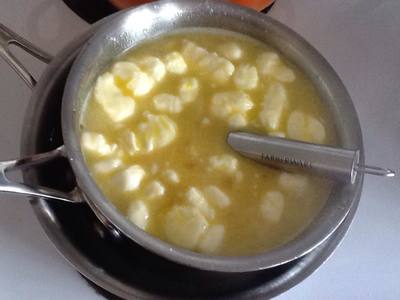|
Canned Lemon Curd
Special Equipment Needed: lemon zester, balloon whisk, 1½ quart double boiler*** (the top double boiler pan should be at least 1½-quart volume), strainer, kitchen thermometer measuring at least up to 180°F, glass or stainless steel medium mixing bowl, silicone spatula or cooking spoon, and equipment for boiling water canning. Yield: About 4 half-pint jars Procedure: Wash 4 half-pint canning jars with warm, soapy water. Rinse well; keep hot until ready to fill. Prepare canning lids according to manufacturer's directions. Fill boiling water canner with enough water to cover the filled jars by 1 to 2 inches. Use a thermometer to preheat the water to 180°F by the time filled jars are ready to be added. Caution: Do not heat the water in the canner to more than 180°F before jars are added. If the water in the canner is too hot when jars are added, the process time will not be long enough. The time it takes for the canner to reach boiling after the jars are added is expected to be 25 to 30 minutes for this product. Process time starts after the water in the canner comes to a full boil over the tops of the jars. Combine the sugar and lemon zest in a small bowl, stir to mix, and set aside about 30 minutes. (I did not use super fine sugar - instead I used granulated white sugar and placed that and the lemon zest in my Cuisinart and pulsed until it was blended and superfine.) Pre-measure the lemon juice and prepare the chilled butter pieces. Heat water in the bottom pan of the double boiler until it boils gently. The water should not boil vigorously or touch the bottom of the top double boiler pan or bowl in which the curd is to be cooked. Steam produced will be sufficient for the cooking process to occur. In the top of the double boiler, on the counter top or table, whisk the egg yolks and whole eggs together until thoroughly mixed. Slowly whisk in the sugar and zest, blending until well mixed and smooth. Blend in the lemon juice and then add the butter pieces to the mixture. Place the top of the double boiler over boiling water in the bottom pan. Stir gently but continuously with a silicone spatula or cooking spoon, to prevent the mixture from sticking to the bottom of the pan. Continue cooking until the mixture reaches a temperature of 170°F. Use a food thermometer to monitor the temperature. Remove the double boiler pan from the stove and place on a protected surface, such as a dish cloth or towel on the counter top. Continue to stir gently until the curd thickens (about 5 minutes). Strain curd through a mesh strainer into a glass or stainless steel bowl; discard collected zest. Fill hot strained curd into the clean, hot half-pint jars, leaving 1/2-inch head-space. Remove air bubbles and adjust head-space if needed. Wipe rims of jars with a dampened, clean paper towel; apply two-piece metal canning lids. Process in the prepared boiling water canner 15 minutes 0 - 1,000ft 20 minutes 1,001 - 6000ft 25 minutes above 6,001ft Let cool, undisturbed, for 12 to 24 hours and check for seals. Shelf Life: For best quality, store in a cool, dark place (away from light). Plan to use canned lemon curd within 3 to 4 months. Browning and/or separation may occur with longer storage; discard any time these changes are observed. Prepared lemon curd can also be frozen instead of canned for up to 1 year without quality changes when thawed. Package in freezer containers after straining and cooling to room temperature. To thaw, place container in a refrigerator at 40°F or lower for 24 hours before intended use. After thawing, consume within 4 weeks. Preparation Notes: * If superfine sugar is not available, run granulated sugar through a grinder or food processor for 1 minute, let settle, and use in place of superfine sugar. Do not use powdered sugar. ** Bottled lemon juice is used to standardize acidity. Fresh lemon juice can vary in acidity and is not recommended. *** If a double boiler is not available, a substitute can be made with a large bowl or saucepan that can fit partway down into a saucepan of a smaller diameter. If the bottom pan has a larger diameter, the top bowl or pan should have a handle(s) that can rest on the rim of the lower pan. Variation: For Lime Curd, use the same recipe but substitute 1 cup bottled lime juice and ¼ cup fresh lime zest for the lemon juice and zest. Other citrus or fruit curds are not recommended for canning at this time. Two Great references/reads: NCHFP Lemon Curd Recipe Link Great Article (.pdf) from NCHFP on Lemon Curd Recipe by: NCHFP Photos by: Diane Baker for Canning and Cooking at Home
0 Comments
Your comment will be posted after it is approved.
Leave a Reply. |










